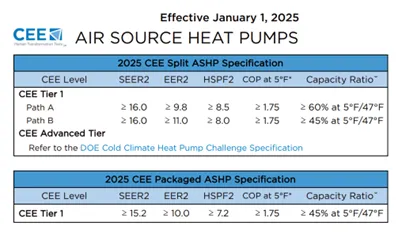As we approach January 1, 2025, the Consortium for Energy Efficiency (CEE) has announced key updates to the Residential Electric HVAC Specifications, which will impact tax credit eligibility for heat pumps and other high-performing HVAC systems. This revision aims to simplify specifications and set a clearer standard for national market transformation, with the primary goal of making energy-efficient options more accessible and impactful across diverse climate zones and building types.
Key Objectives of the New Specifications
The updated 2025 HVAC Specifications focus on several core objectives to boost the adoption of energy-efficient systems:
1. Simplifying the Specification Structure: The streamlined specifications aim to increase the penetration of high-performing systems, making it easier for contractors and consumers to understand and select eligible products.
2. Supporting Contractor and Consumer Discretion: By considering diverse climate zones, building types, and existing HVAC setups, the new specifications offer flexibility, allowing contractors and consumers to choose systems that best fit their unique needs.
3. Encouraging Market Transformation: The updated guidelines establish performance criteria designed to benefit both customers and the electrical grid, supporting a broader push toward national market transformation.
4. Directing Future Demand Flexibility: These specifications set a path for the industry to adapt to future demands, creating a foundation for a more resilient and responsive HVAC market.

What Does This Mean for 25C Tax Credit Eligibility?
Under the 25C tax credit program, homeowners can receive credits on qualifying energy-efficient home improvements, including high-efficiency heat pumps and central air conditioners that meet specific requirements. The CEE updates ensure that tax-credit-eligible systems align with these refined performance standards, allowing contractors to offer clients both savings on their installation and ongoing energy costs. As contractors, verifying that products meet these tax credit criteria is essential; manufacturers will provide updates on compliant units, keeping you informed about eligible product options.
Transition to the Enhanced AHRI Directory
CEE is collaborating with the Air-Conditioning, Heating, and Refrigeration Institute (AHRI) to incorporate the updated specifications into the AHRI Directory starting January 1, 2025. The current CEE Directory site will no longer be available as these listings transition to the AHRI platform, ensuring easier access to product information for contractors, distributors, and consumers alike.
Resources for Contractors
To help you adapt to these changes, the MN ASHP Collaborative remains committed to providing timely updates. We encourage contractors to review the new specifications in detail on the official CEE website, where the full 2025 and 2026 requirements are outlined. Additionally, for a summary of the current ASHP standards, refer to the latest specification summary table on the MN ASHP Collaborative website.
By staying informed on these specification updates and tax credit criteria, contractors can continue delivering efficient, high-performance HVAC solutions that align with national goals for energy efficiency and customer savings. For any questions or further clarification, reach out to your manufacturer or visit the Consortium for Energy Efficiency website for detailed information.
Please note that the Consortium for Energy Efficiency (also known as CEE) is a separate organization from Center for Energy and Environment (CEE) that operates the MN ASHP Collaborative.